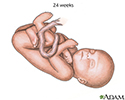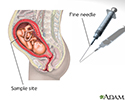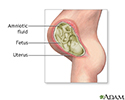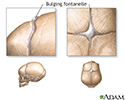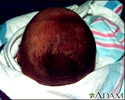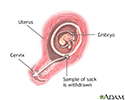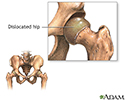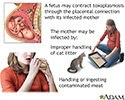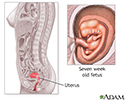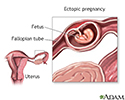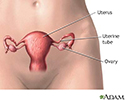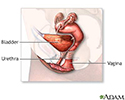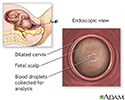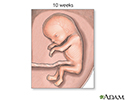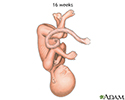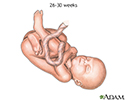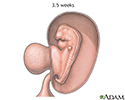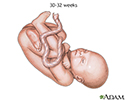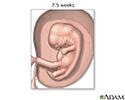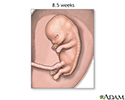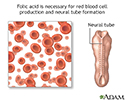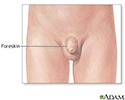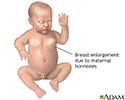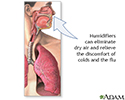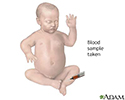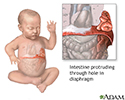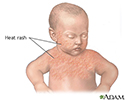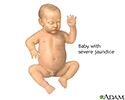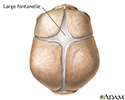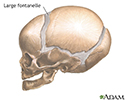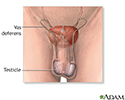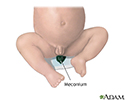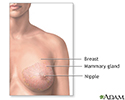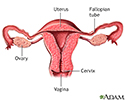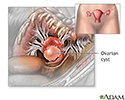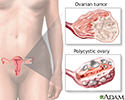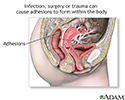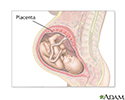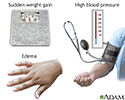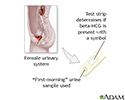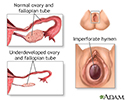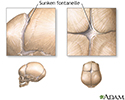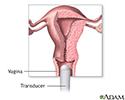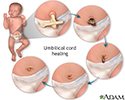Multimedia Gallery
The role of amniotic fluid
Inside a pregnant woman’s uterus is an amniotic sac, which contains amniotic fluid and the growing fetus.
The amniotic fluid is important for several reasons -- it helps keep the baby warm, and because his body parts are growing so fast, the fluid provides lubrication that keeps them from growing together. In some cases, fingers and toes can become webbed as a result of not enough amniotic fluid circulating in the uterus.
The amniotic fluid also lets the baby move easily so he can exercise his muscles and strengthen his bones before he’s born.
In addition, it acts like a liquid shock absorber for the baby by distributing any force that may push on the mother’s uterus. Even sex won’t hurt the baby.
Amniotic fluid is 98% water and 2% salts and cells from the baby. Until the fetal kidneys started working during month four, amniotic fluid is made by the mother’s body. But after month four, the little guy started to make his contribution to the amniotic fluid by urinating in it.
You heard right. It may not sound appealing to us, but the urine in the amniotic sac is completely harmless to the baby.
The baby swallows amniotic fluid, which then passes through his digestive system, into his kidneys, and back out again to the amniotic sac as urine. In this way, he can practice using his digestive and urinary systems before he’s even born. In fact, doctors can tell by the amount of amniotic fluid whether the baby has difficulty with his swallowing reflex.
By the time he’s born, he will consume up to 13 ounces of amniotic fluid a day.
The role of amniotic fluid
Review Date: 10/15/2024
Reviewed By: John D. Jacobson, MD, Professor Emeritus, Department of Obstetrics and Gynecology, Loma Linda University School of Medicine, Loma Linda, CA. Also reviewed by David C. Dugdale, MD, Medical Director, Brenda Conaway, Editorial Director, and the A.D.A.M. Editorial team.
Animations
- Breast engorgement
- Cell division
- Cesarean section
- Conception - general
- Conception - pregnancy
- Conception of identical twins
- C-section
- Early labor
- Egg cell production
- Egg production
- Endometriosis
- Fetal ear development
- Formation of twins
- Human face formation
- Infant formulas
- Kids - How big is the baby?
- Kids - How does the baby co...
- Kids - Is it a girl or boy?
- Kids - Umbilical cord
- Kids - Where do babies come...
- Newborn jaundice
- NICU consultants and suppor...
- Ovulation
- Placenta delivery
- Placenta formation
- Preeclampsia
- Pregnancy
- Pregnancy care
- Sperm production
- Sperm release pathway
- Storing breast milk
- The role of amniotic fluid
- Twin-to-twin transfusion sy...
- Ultrasound
- Vaginal delivery
Illustrations
- 24-week fetus
- Abnormal discharge from the...
- Abnormal menstrual periods
- Absence of menstruation (am...
- Amniocentesis
- Amniocentesis
- Amniotic fluid
- Amniotic fluid
- Anatomy of a normal placenta
- Antibodies
- Baby burping position
- Bananas and nausea
- Blood cells
- Blood test
- Breast infection
- Breastfeeding
- Bulging fontanelles
- Candida - fluorescent stain
- Caput succedaneum
- Cesarean section
- Cesarean section
- Cesarean section
- Childbirth
- Chorionic villus sampling
- Congenital hip dislocation
- Congenital toxoplasmosis
- Crying - excessive (0 to 6 ...
- Delivery presentations
- Developmental milestones
- Early weeks of pregnancy
- Ectopic pregnancy
- Emergency Childbirth
- Emergency Childbirth
- Endocrine glands
- Endometriosis
- Endometritis
- Erythroblastosis fetalis - ...
- Female breast
- Female reproductive anatomy
- Female reproductive anatomy
- Female reproductive anatomy...
- Female urinary tract
- Fetal blood testing
- Fetal head molding
- Fetus at 10 weeks
- Fetus at 12 weeks
- Fetus at 16 weeks
- Fetus at 26 to 30 weeks
- Fetus at 3.5 weeks
- Fetus at 30 to 32 weeks
- Fetus at 7.5 weeks
- Fetus at 8.5 weeks
- First trimester of pregnancy
- Folic acid
- Folic acid benefits
- Folic acid source
- Follicle development
- Fontanelles
- Foreskin
- Gestational ages
- Gestational diabetes
- Gonadotropins
- Head circumference
- Heat rash
- Height/weight chart
- Hormonal effects in newborns
- Humidifiers and health
- Hysterectomy
- Infant blood sample
- Infant care following delivery
- Infant diaphragmatic hernia
- Infant heat rash
- Infant intestines
- Infant jaundice
- Infantile reflexes
- Influenza vaccines
- Intraductal papilloma
- Intrauterine transfusion
- Jaundiced infant
- Large fontanelles
- Large fontanelles (lateral view)
- Macrosomia
- Male reproductive anatomy
- Male reproductive anatomy
- Male urinary tract
- Mammary gland
- Meconium
- Morning sickness
- Moro reflex
- Newborn head molding
- Newborn test
- Normal female breast anatomy
- Normal uterine anatomy (cut...
- Ovarian cyst
- Ovarian hypofunction
- Overproductive ovaries
- Pelvic adhesions
- Pelvic laparoscopy
- Placenta
- Placenta
- Placenta
- Placenta previa
- Polyhydramnios
- Preeclampsia
- Pregnancy test
- Primary amenorrhea
- Primary infertility
- Secondary amenorrhea
- Secondary infection
- Side sectional view of fema...
- Single palmar crease
- Skull of a newborn
- Slit-lamp exam
- Sperm
- Stein-Leventhal syndrome
- Sunken fontanelles (superio...
- Tobacco health risks
- Transvaginal ultrasound
- Ultrasound in pregnancy
- Ultrasound, color - normal ...
- Ultrasound, normal fetus - ...
- Ultrasound, normal fetus - ...
- Ultrasound, normal fetus - ...
- Ultrasound, normal fetus - face
- Ultrasound, normal fetus - ...
- Ultrasound, normal fetus - foot
- Ultrasound, normal fetus - ...
- Ultrasound, normal fetus - ...
- Ultrasound, normal fetus - ...
- Ultrasound, normal fetus - ...
- Ultrasound, normal placenta...
- Ultrasound, normal relaxed ...
- Umbilical cord healing
- Uterus
- Vaginal bleeding during pre...
- Well baby visits
- Yeast infections

 Bookmark
Bookmark



































